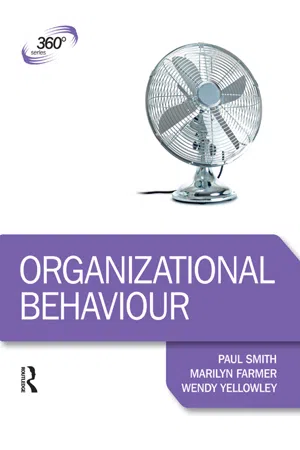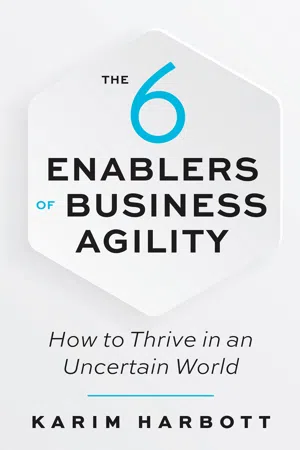Business
Team Structure
Team structure refers to the way in which a team is organized and how its members interact. It encompasses the division of tasks, roles, and responsibilities within the team. A well-defined team structure can enhance communication, collaboration, and productivity, ultimately contributing to the achievement of organizational goals.
Written by Perlego with AI-assistance
Related key terms
Related key terms
1 of 4
Related key terms
1 of 3
5 Key excerpts on "Team Structure"
- eBook - ePub
Organizational Behavior
A Management Challenge
- Linda K. Stroh, Gregory B. Northcraft, Margaret A. Neale, (Co-author) Mar Kern, (Co-author) Chr Langlands, Jerald Greenberg(Authors)
- 2001(Publication Date)
- Routledge(Publisher)
Organizational design is the process of creating this structure, grouping roles and activities so that the interdependencies among organizational actors are coordinated effectively and efficiently.A common way in which an organization’s structure is represented to employees and others is through an organizational chart, such as the one shown in Figure 14–1 . An organizational chart denotes the formal lines of authority in an organization. Each box on the chart represents a position. Boxes are connected to each other with solid vertical lines (indicating direct reporting relationships). Solid horizontal lines represent communication (but not authority) relationships. Broken lines represent informal or infrequent relationships.This chapter describes the most common organizational structures and examines the ways they influence the relationships and interactions of the members of an organization. It then identifies the factors that influence whether a particular organizational structure is effective. It also examines some of the symptoms that emerge when an organization’s structure is inappropriate.FIGURE 14–1 A Hospital: An Organization Structured by Knowledge and SkillsSource: Mintzberg, H. (1979). The structuring of organizations. Englewood Cliffs, NJ: Prentice Hall.ELEMENTS OF ORGANIZATIONAL STRUCTURE
An organization’s structure reflects the way the organization distributes and coordinates work. As shown in the opening vignette about P&G, this structure can be a powerful strategic force. An appropriate structure is essential to the efficient attainment of an organization’s goals. In this section, we will consider four design features that organizations use to divide and coordinate work: job specialization, departmentalization, centralization/decentralization, and span of control. - eBook - ePub
- Paul Smith, Marilyn Farmer, Wendy Yellowley(Authors)
- 2013(Publication Date)
- Routledge(Publisher)
Sunday Times top 100 companies to work for. The company scores highly on team-working and is structured on the basis of ten sales teams, with six employees in each, who each spend their time on the phone or connecting with their own set of clients, to market, sell and provide advice on a range of technology-based products. The teams all have a team leader, whose responsibility it is to communicate to the team any product changes, agree targets, monitor progress and support each team member to be successful. As the business expands, the teams have increased in size, but there remains a very close, cohesive feel to the organization, as team members have a ‘voice’ in decision-making and there is an element of competition between teams. One team member said, ‘the team is like a family in a way, as although the company is growing rapidly it still feels personal and you still feel connected to people as you are in a team. Somehow it makes you feel valued.’This company has so far operated with small teams of six, and it is interesting to note that research into the optimum size of team suggests between six and nine team members. In addition, the experience of the team member clearly indicates the psychological connection that she felt in working for the organization.In the case study above, the organization had made a clear decision to structure employees on the basis of sales teams. Although team members had individual targets, they were clearly connected to a team with a team leader, chose their own team name and were also set some team targets, to encourage a degree of competition between teams. Other organizations may utilize team terminology in a much looser way, with employees assigned to a large production team or departmental team, with the emphasis placed more firmly on individual contribution.5.7 Team roles
The most well-established investigation carried out into team roles is the work by Belbin (1993) and his team of researchers at Cambridge University. They investigated team roles over a period of time and identified some common roles that appeared crucial to effective team-working. In each team, individuals tend to adopt a preferred role or set of roles. The research is based on individuals completing a self-perception inventory, the results of which highlight the dominant team role and the secondary team roles that the individual will typically play. The research is ongoing, and while initially eight roles were identified, this was later extended to nine. In Table 5.2 , Belbin's nine team roles are described, along with a brief interpretation of each one. To find out what your preferred team role is, you can visit www.belbin.com - eBook - ePub
The 6 Enablers of Business Agility
How to Thrive in an Uncertain World
- Karim Harbott(Author)
- 2021(Publication Date)
- Berrett-Koehler Publishers(Publisher)
A foundation of trust, transparency, and psychological safety. The sense that teammates can be relied upon, and a feeling that it is OK to ask for help, make mistakes, and be vulnerable. This underpins all relationships, collaboration, and teamwork.■ Clarity and alignment around the objectives. An unambiguous mutual understanding of what is to be achieved. This is the sense of direction.■ Requisite knowledge and capability. The correct skillset on the team to achieve the objective. This ensures the team is able to travel in the desired direction.■ Requisite tools and resources. Access to everything the team will need to achieve the objective. This allows the team to travel more quickly in the desired direction.■ Aligned incentives. No conflict between individual, team, and organizational interests. This ensures that the desired direction of travel is the same for all.■ No external barriers to success. Nothing outside the control of the team that will be an impediment to delivery. This ensures that there are no roadblocks.FIGURE 14 The pillars of self-managing teamsWhat is clear is that organizational structure can have a disproportionate effect on team performance and should therefore be at the forefront of leaders’ thoughts. While teams should be accountable for delivering results, the absence of any of the aforementioned pillars will likely have a detrimental effect, and it’s the responsibility of leaders to ensure these are in place. I rarely encounter truly bad teams, just teams operating under bad leadership. With that in mind, next, I will outline four key principles for organizational structures that support business agility and innovation. If organizations fail to embrace these, and to learn lessons from the story of electricity, many will incur the same 40-year lag between the emergence of agile approaches and the achievement of true business agility. This will see them figure it out sometime around 2041. Assuming, of course, that they survive that long. - eBook - ePub
Beyond Multi-Channel Marketing
Critical Issues in Dual Marketing
- Maria Palazzo, Pantea Foroudi, Alfonso Siano, Maria Palazzo, Pantea Foroudi, Alfonso Siano(Authors)
- 2020(Publication Date)
- Emerald Publishing Limited(Publisher)
Nonaka & Takeuchi, 1995 ). In addition, this structure's pillars depart from the view that the only knowledge valuable to the organisation is formal and systematic (i.e. hard information), and instead they assume the importance of tacit knowledge and not quantifiable information.Organisations – at least those of sufficient size – are usually internally divided into departments, that group together homogeneous activities. Organisations vary with regard to departmentalisation, i.e. the way of assigning different activities to different departments. The most commonly adopted types of departmentalisation determine typical structural configurations. The evolution of organisational forms goes hand in hand with the sequences of economic eras in the history of the industrialised world (Miles, Miles, Snow, Blomqvist, & Rocha, 2009 ). When scholars first started studying organisational forms, companies had structures with clearly separated units, which made it easier to individuate few model structures. The early types individuated were the functional structure and the multidivisional structure. The first structure to see daylight was the functional one, also known as the U-form, whose adoption dates back to the early 1900s, when Henry Ford was refining the well-known Model T automobile (Miles et al., 2009 ). In the early days of industrialisation, managers used to model their businesses serving solely the objective of large-scale production (i.e. sales volumes and cost savings), without worrying about demand capacity and customers' needs. In this context, products were maximally standardised and the organisational design pursued specialisation of units and economies of scale. Therefore, workers were grouped according to their areas of expertise and were directly dependent upon the higher business levels. In this mechanistic structure, each unit is made of workers appointed with particular activities, and it is responsible for a specific business function (human relations, R&D, finance, operations, etc.) or area of expertise (Habib & Victor, 1991 - eBook - ePub
- John Bennett(Author)
- 2013(Publication Date)
- Routledge(Publisher)
Specialist . This recognizes the fundamental need for technological competence if teams are to be effective in adding value for customers.Competent peopleSo in summary, the first principle of effective organization structures is that the people involved should be competent. This means they are technically competent, multi-skilled, able to work effectively at the level of work required by their task and are competent at one or more team roles. Achieving this may require careful selection procedures, education, training, mentoring and re-training.RelationshipsTalented individuals will be fulfilled by working on higher levels of work. This does not mean moving up through a management hierarchy. It means tackling long-term issues involving many complex and uncertain factors. It means balancing current activities with future requirements. It means scanning the world-wide environment for developments that may influence current projects. It means working strategically on the basis of values, ethics and cultures agreed within the teams, larger organizations and communities of which the talented individuals are a part. It follows that the second principle of structure deals with these relationships between people.Construction organizations are shaped by the relationships people form and find useful. The significance of this is that organization structures are formed, not by senior managers drawing organization charts but by people communicating. Senior managers influence the patterns of communications by the way they allocate work, decide its location and distribute resources. They can, for example, decide to set up information technology networks that connect some work units and exclude others. However, the more these decisions reflect and reinforce the naturally occurring patterns of communication, the more effective they will be.
Index pages curate the most relevant extracts from our library of academic textbooks. They’ve been created using an in-house natural language model (NLM), each adding context and meaning to key research topics.
Explore more topic indexes
Explore more topic indexes
1 of 6
Explore more topic indexes
1 of 4




